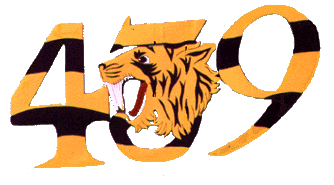|
History
of
 Squadron Squadron
  
Chapter
IV
The
Battle of Normandy
June
- August 1944
Intentionally
left blank.
|
Thirty-six sorties were flown on 11 August (a new
record for the Squadron) on four operations which were all "wing
shows". Two
were on behalf of the Polish Division which was held
up by enemy resistance in woods near Estrees-la-Campagne. In the first
attack the northern half of the area, was turned into a shambles and a few
hours later the squadrons returned to pound the southern section into
submission. The Polish troops signaled
their "deepest
thanks" for "a
magnificent job." The third target was a wood in which an enemy
ammunition dump was believed to be concealed, but the Tiffie pilots
concluded it must have been moved before they arrived. Although their
bombing was dead on the aiming-point, no tremendous flashes of exploding
ammunition could be seen. The final job of the day was to knock out enemy defenses
on a hill in the Conde-sur-Noireau area which the Guards armoured brigade
was attacking. One Typhoon
squadron was assigned the forward slope, another the reverse, and No. 439
was given the hill-top, dominated by a large building.
From 9,000 feet the pilots half-rolled into a steep dive, using the
building as their aiming point; several fired their cannons on the way down "to
add to the confusion below". The
bombs, bursting near the building and along the crest of the hill, threw up
great clouds of dust. Flak batteries; opened up with an intense and
uncomfortably accurate barrage as the Typhoons broke away from the target.
On the first show that day much time was consumed orbiting over the airfield
waiting for the squadrons of the wing to form up or take their turn to
pancake. Thereafter each squadron proceeded independently to the target,
flying in the old comfortable battle "fours" instead of "threes", and everyone was
much happier as no tempers were frayed by
useless circling.
|
The
12th
was a day of perfect weather, without the usual morning haze, and the
Squadron was able to begin operations before 10 a.m., sending out a
formation of nine to hit a group of buildings near Vassy where the 9th
S.S. Panzer Division was believed to have its headquarters. The first
section picked the wrong group of buildings, but the other five were
on the right target which they clobbered with six direct hits. Flak
was again unpleasantly accurate, but the aircraft returned safely.
Then the Squadron's luck changed.
|
Flying
Officer Ernest J. Allen
Photo
not currently available.
|
The southward drive of the Canadians from
Bretteville and the northward advance of the Americans towards Falaise
were drawing an iron ring around the Nazi Seventh Army in the area
between Thury-Harcourt and Piers. The
escape routes eastward all
crossed the Orne River, and 143 Wing was assigned the job of smashing
three small bridges, at St. Marc d'Ouilly, Taillebois and Le Pont des
Vers, to impede the Hun retreat. Nos.
438 and 440 went in first; then No. 439 attacked, detailing a section of
four for each bridge. As was to be expected, the flak defences at these
vital targets were plentiful. F/O
Ernie Allen's aircraft was the first to be hit, a burst clipping his
starboard wing and main tanks. Enveloped in smoke, the Typhoon fell out
of control. Ernie was seen to bail out and swing earthward near one of
the bridges. Everyone hoped that Ernie's WD (Women’s Division) wife,
whom he had visited in England just a few days previously, would soon
receive word that her husband was safe, even though a prisoner, but fate
ruled otherwise. Months
later information came through that he had been killed, either in the
air or after reaching the ground, and was buried in a little town by the
banks of the Orne.
  
Copyright ©1998-2016 Michael T. Melnick. All rights reserved the unofficial homepage of  Tiger Squadron Tiger Squadron . . ..
|
|